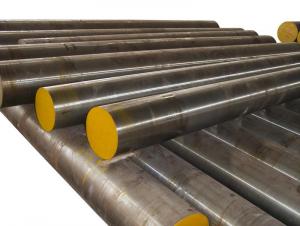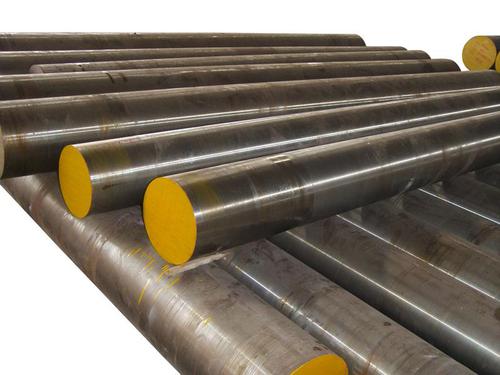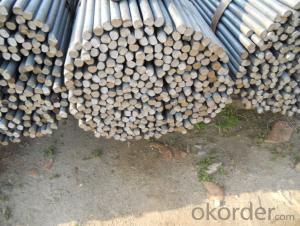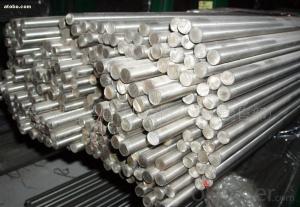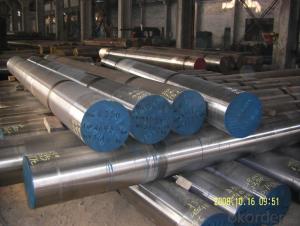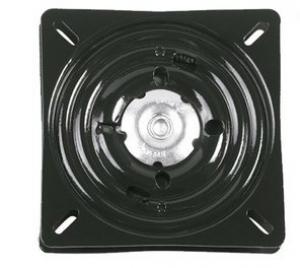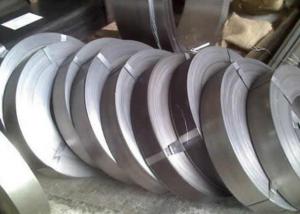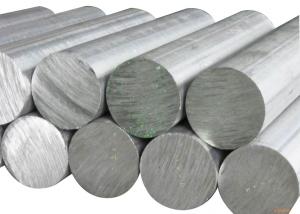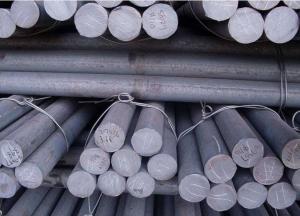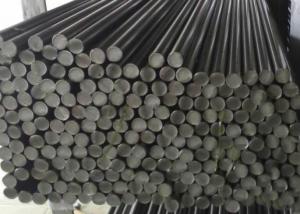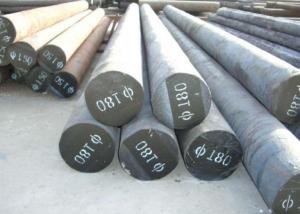Hot Rolled Bearing Steel Bar with High Quality for Construction
- Loading Port:
- China main port
- Payment Terms:
- TT or LC
- Min Order Qty:
- 25000 m.t.
- Supply Capability:
- 100000 m.t./month
OKorder Service Pledge
OKorder Financial Service
You Might Also Like
Specifications of Hot Rolled Bearing Steel Bar GCr15 with High Quality for Construction:
1. Dimensional sizes: Thickness: 14~100mm.Length:3000~5800mm,Diameter :14-500mm
2.Chemical composition:
C | Si | Mn | Cr | Ni | Cu |
Equal or less than | |||||
0.95-1.05 | 0.15-0.35 | 0.20-0.40 | Cr:1.30-1.65 | 0.30 | 0.25 |
3. Grade: SAE51200/ GCr15 / 100cr6
4. Heat Treatment:
Soft annealing: heat to 680-720°C, cool slowly.
Hardness after annealing: Max. 241 HB
Hardening: 820 - 850 °C
Normalizing temperature: 840-880°C
Tempering: 540-680°C
5. Surface requirements: Black, grinding, bright, polish
6. Characters:
1) Comprehensive properties
2) Good performance in cutting and processing after spheroids annealing
3) High hardness and homogenization after quenching and tempering
4) High abrasive resistance and fatigue resistance
7. Payment terms: T/T or L/C at sight
Usage & Applications of Hot Rolled Bearing Steel Bar GCr15 with High Quality for Construction:
Our products have been used in all kinds of areas, such as aviation, aerospace, navigation, nuclear, energy, chemical industry, electronic information, petrochemical, automotive, instrument and meter, Communication ,transportation, and medical instruments, etc. Bearing ring,steel rolling mill ,machinery, 100Cr6 bearing steel ball is widely used in high-speed and low-noise bearing, bicycle, motorcycle, automobile, bags, electronics.
Packaging & Delivery of Hot Rolled Bearing Steel Bar GCr15 with High Quality for Construction:
Mark: Heat No. will be cold stamped and Steel grade, diameter (mm), length (mm), and the manufacturer LOGO and weight (kg) is painted.
Standard seaworthy packing or as customer required
Delivery time: Within 30 days after order is confirmed.
FAQ:
Q1: Why buy Materials & Equipment from OKorder.com?
A1: All products offered byOKorder.com are carefully selected from China's most reliable manufacturing enterprises. Through its ISO certifications, OKorder.com adheres to the highest standards and a commitment to supply chain safety and customer satisfaction.
Q2: How do we guarantee the quality of our products?
A2: We have established an advanced quality management system which conducts strict quality tests at every step, from raw materials to the final product. At the same time, we provide extensive follow-up service assurances as required.
Q3: How soon can we receive the product after purchase?
A3: Within three days of placing an order, we will begin production. The specific shipping date is dependent upon international and government factors, but is typically 7 to 10 workdays.
Images:
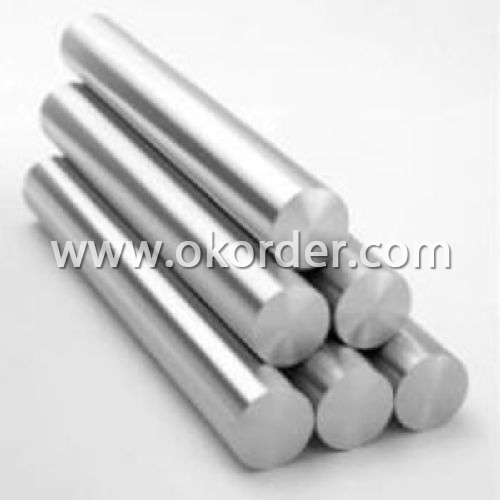

Note:
1. According to national standard (GB) for our products, if not, supply according to national standards (GB) or agreement.
2. We can not only provide electric furnace +LF+VD and electro-slag re-melting (ESR)steel forging materials, but also forging products of piece, bar, etc.
3. Our company is equipped with roll equipment and can provide our customers with roll billets or finished.
4. Please send us your detailed specifications when inquire. We will reply to you ASAP.
- Q: How can I determine the cooling water flow of square billet mold for special steel?
- Mold heat balance method. If the heat of the molten steel in the mould is taken away from the cooling water, the heat released by the solidification of the molten steel is equal to the amount taken away by the cooling water
- Q: What are the different methods of joining special steel?
- There are various techniques available for joining special steel, each presenting its own advantages and limitations. Some of the most frequently employed methods comprise: 1. Welding: The most prevalent technique for joining steel involves melting the base material and incorporating a filler material to establish a robust connection. Depending on the specific requirements, different welding techniques like arc welding, gas welding, and laser welding can be utilized. 2. Brazing: This approach necessitates heating the steel and melting a filler metal with a lower melting point, which then infiltrates the joint through capillary action. Brazing is commonly employed when joining dissimilar metals or when a lower-temperature joining process is indispensable. 3. Soldering: Similar to brazing, soldering also employs a filler material with a lower melting point to join the steel. However, soldering involves melting the filler material without melting the base material. It is often employed for electrical connections and delicate applications. 4. Mechanical fastening: This method entails utilizing mechanical means such as bolts, screws, rivets, or other types of fasteners to join the steel components. Mechanical fastening is frequently favored in situations where disassembly or maintenance is necessary. 5. Adhesive bonding: Special steel can also be joined using adhesives that establish a sturdy bond between the surfaces. Adhesive bonding is suitable for joining intricate shapes, minimizing stress concentrations, and providing exceptional corrosion resistance. 6. Friction welding: This technique involves the application of pressure to rub or spin two steel components together, generating heat that creates a bond. Friction welding is commonly employed for joining high-strength or heat-treated steels. 7. Explosive welding: This method employs explosives to facilitate a high-speed collision between two steel surfaces, resulting in a bond formed in a solid state. Explosive welding is frequently used for joining dissimilar metals or when high strength and corrosion resistance are required. The selection of the appropriate joining method depends on factors such as the type of steel, the desired strength and durability of the joint, the specific application requirements, and the availability of equipment and expertise.
- Q: How does special steel perform in terms of creep resistance at elevated temperatures?
- Special steel is known for its excellent performance in terms of creep resistance at elevated temperatures. Creep refers to the gradual deformation of a material under constant stress at high temperatures over an extended period. Special steel, specifically designed to withstand high temperatures, demonstrates a remarkable ability to resist creep and maintain its structural integrity. The unique composition of special steel, which includes various alloying elements such as chromium, molybdenum, and vanadium, contributes to its exceptional creep resistance. These alloying elements enhance the steel's high-temperature strength, increase its resistance to deformation, and inhibit the formation of detrimental microstructural changes that can occur during creep. Furthermore, special steel undergoes specific heat treatment processes, such as quenching and tempering, which further enhance its creep resistance. These processes help refine the steel's microstructure, resulting in a fine-grained and homogenous material that can resist deformation even under prolonged exposure to high temperatures. The superior creep resistance of special steel makes it a preferred choice in various industries that operate under high-temperature conditions, such as power generation, petrochemical, and aerospace. It allows for extended service life, reduced maintenance, and increased safety in critical applications where failure due to creep deformation could have severe consequences. In summary, special steel exhibits exceptional performance in terms of creep resistance at elevated temperatures. Its unique composition, including alloying elements and specific heat treatment processes, enables it to resist deformation and maintain its structural integrity even under prolonged exposure to high temperatures.
- Q: How does free-cutting steel improve machinability?
- Free-cutting steel improves machinability by containing additional elements, such as sulfur, lead, or phosphorus, which help to break the chips and aid in chip removal during the machining process. These elements act as lubricants, reducing friction and heat generation, which results in improved surface finish and reduced tool wear.
- Q: Can special steel be used in the medical device manufacturing industry?
- Yes, special steel can be used in the medical device manufacturing industry. Special steel alloys, such as stainless steel or titanium, are commonly used in medical device manufacturing due to their excellent corrosion resistance, biocompatibility, and strength characteristics. These alloys are specifically designed to meet the stringent requirements and regulations of the medical industry, making them ideal for producing safe and durable medical devices.
- Q: What are the limitations of special steel in certain applications?
- Certain applications have limitations when it comes to special steel, despite its high versatility and durability. One limitation is its cost, as special steel is typically more expensive to produce compared to regular steel. This is due to the addition of various alloying elements. Therefore, in applications where cost is a significant factor, such as large-scale projects or industries with tight budgets, special steel may not be economically viable. Another limitation is its susceptibility to corrosion. Although special steel is generally more resistant to corrosion than regular steel, it is still not entirely immune. In environments with high levels of moisture, chemicals, or extreme temperatures, special steel may corrode over time if not properly protected or maintained. Formability and workability are also limited with special steel. Its higher strength and hardness make it more challenging to shape, bend, or weld compared to regular steel. This restricts its use in applications that require complex or intricate designs, as well as those involving extensive fabrication or assembly processes. Moreover, special steel may face limitations in terms of availability and supply chain. Not all types of special steel may be easily found in the market, especially in remote or less developed regions. This can make it difficult to source the required special steel for specific applications, potentially causing delays or compromises in project execution. Lastly, the specialized properties of special steel may not always be necessary or advantageous for certain applications. In such cases, regular steel or alternative materials might be more suitable and cost-effective, especially if the specific properties of special steel are not required. In conclusion, while special steel offers numerous benefits, it is important to consider its limitations in certain applications. Thorough evaluation of the specific requirements, cost-effectiveness, and availability of special steel is crucial to ensure its successful and optimal use in any given situation.
- Q: What are the applications of special steel in aerospace engineering?
- Special steel is widely used in aerospace engineering for various applications. It is used to manufacture critical components such as turbine blades, landing gear, and structural parts that require high strength, toughness, and resistance to extreme temperatures. Special steel alloys, such as stainless steel and nickel-based alloys, are used due to their excellent corrosion resistance, heat resistance, and ability to withstand harsh environments. These materials ensure the safety and reliability of aircraft, enabling them to operate under demanding conditions and meet stringent performance requirements.
- Q: How does special steel contribute to the formability of products?
- Special steel contributes to the formability of products by providing enhanced mechanical properties, such as higher strength, toughness, and ductility. These properties allow the steel to be shaped and formed into complex geometries without cracking or deforming. Additionally, special steel alloys may have improved resistance to corrosion, wear, and heat, enabling the production of durable and long-lasting products.
- Q: What are the main challenges in welding special steel?
- The main challenges in welding special steel typically include issues such as high heat input requirements, susceptibility to cracking, and the need for precise preheating and post-weld heat treatment. Additionally, the presence of alloying elements in special steel can make it more difficult to achieve the desired mechanical properties and require careful selection of filler materials.
- Q: How does special steel contribute to the robotics industry?
- The robotics industry benefits greatly from the use of special steel, which plays a vital role in its advancement. To begin with, special steel alloys possess extraordinary mechanical properties that make them ideal for manufacturing various robotic components. These alloys provide exceptional strength, durability, and resistance to wear and tear. Consequently, robots built with special steel can operate efficiently and reliably even in demanding environments like manufacturing plants or hazardous locations. Furthermore, special steel alloys offer outstanding heat resistance and thermal stability, a crucial characteristic in robotics. As robots often generate significant heat during operations, special steel components can withstand high temperatures without deforming or losing their structural integrity. This capability ensures that robots can perform optimally without the risk of mechanical failures caused by heat-related issues. Additionally, the corrosion resistance of special steel is highly advantageous for the robotics industry. Robots are increasingly being used in diverse applications such as underwater exploration, chemical handling, and outdoor environments. In such cases, exposure to moisture, chemicals, or harsh weather conditions can lead to corrosion and degradation of robot parts. By utilizing special steel alloys, manufacturers can significantly prolong the lifespan of robotic systems, reducing maintenance costs and enhancing overall reliability. Moreover, special steel's magnetic properties are invaluable in the development of magnetic sensors and actuators used in robotics. These sensors enable robots to detect and interact with their surroundings, improving their autonomy and adaptability. On the other hand, magnetic actuators enable precise control and movement in robotic systems. Special steel's magnetic properties contribute to the efficiency, accuracy, and responsiveness of these components, allowing robots to execute complex tasks with precision. In conclusion, special steel plays a vital role in the robotics industry by providing the necessary materials for manufacturing robust, high-performance, and versatile robotic systems. The use of special steel alloys enhances strength, durability, and the ability to withstand extreme conditions, ensuring the reliability, efficiency, and functionality of these machines.
Send your message to us
Hot Rolled Bearing Steel Bar with High Quality for Construction
- Loading Port:
- China main port
- Payment Terms:
- TT or LC
- Min Order Qty:
- 25000 m.t.
- Supply Capability:
- 100000 m.t./month
OKorder Service Pledge
OKorder Financial Service
Similar products
Hot products
Hot Searches
Related keywords
